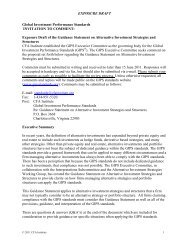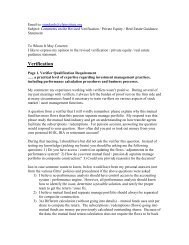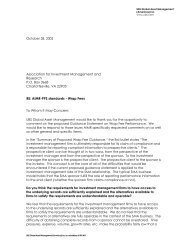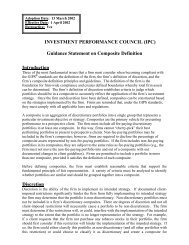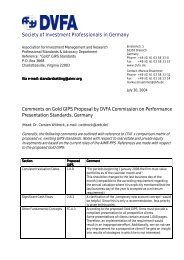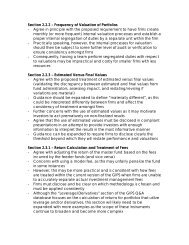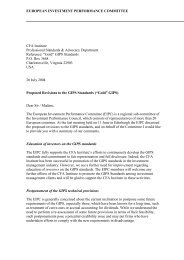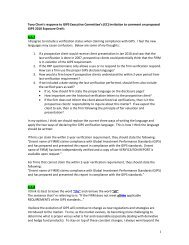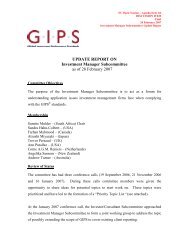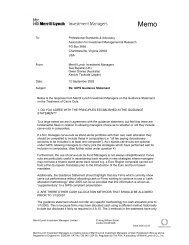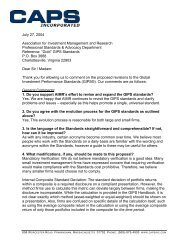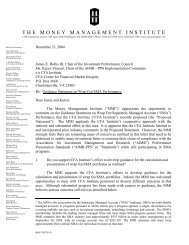Best Practices for Creating and Maintaining Policies and ... - GIPS
Best Practices for Creating and Maintaining Policies and ... - GIPS
Best Practices for Creating and Maintaining Policies and ... - GIPS
You also want an ePaper? Increase the reach of your titles
YUMPU automatically turns print PDFs into web optimized ePapers that Google loves.
e. Subjective unobservable inputs <strong>for</strong> the investment where markets are not active at themeasurement date. Unobservable inputs should only be used to measure fair value tothe extent that observable inputs <strong>and</strong> prices are not available or appropriate.Trade date accounting is used <strong>for</strong> all periods. Accrual accounting is used <strong>for</strong> fixed incomesecurities <strong>and</strong> all other investments that earn interest income. Accrued income is included inbeginning <strong>and</strong> ending portfolio market values when calculating per<strong>for</strong>mance. Dividends areaccrued as of the ex-dividend date.Procedures to consider:• The firm may choose to establish a valuation policy documented outside of the firm’s<strong>GIPS</strong> policies <strong>and</strong> procedures. Such a policy could detail valuation procedures <strong>for</strong>specific asset classes or securities.• Firms should consider having a valuation oversight committee to ensure that valuations ofportfolio investments have integrity <strong>and</strong> fairly reflect their value.• When the firm regularly receives or calculates multiple valuations <strong>for</strong> one portfolio (e.g.,internal valuations compared to those received from the custodian or a fundadministrator), the firm should determine which will be the official valuation source <strong>for</strong>that portfolio <strong>and</strong> use that source consistently.• Firms should establish a regular review of the use of subjective, unobservable inputs todetermine if these investments are material to each of their composite strategies.• Firms’ accruals should be verified through timely reconciliations between the firm’srecords <strong>and</strong> the custodian’s records.Helpful hints:• Firms that typically invest only in liquid securities in active markets should still consideraddressing in their policies <strong>and</strong> procedures potential scenarios where markets suddenlybecome illiquid <strong>and</strong> objective, observable investment prices are unavailable.VII. Portfolio valuation frequencyThe <strong>GIPS</strong> st<strong>and</strong>ards have gradually increased the minimum required frequency of portfoliovaluation from quarterly (prior to 2001), to monthly (from the beginning of 2001 to the end of2009), then to as of each calendar month end or the last business day of the month as well as onthe date of all large cash flows (beginning in 2010). A large cash flow, which is to be defined bythe firm <strong>for</strong> each composite, is the level at which the firm determines that an external cash flow(cash or investments that enter or exit a portfolio) may distort per<strong>for</strong>mance if the portfolio is notvalued at the time of the cash flow. Firms must define the amount in terms of the value of thecash/asset flow or in terms of a percentage of portfolio assets or the composite assets. Firms mustalso determine if a large cash flow is a single external cash flow or an aggregate of a number ofexternal cash flows within a stated period of time.<strong>Best</strong> <strong>Practices</strong> <strong>for</strong> <strong>Creating</strong> <strong>and</strong> <strong>Maintaining</strong> <strong>GIPS</strong> <strong>Policies</strong> & Procedures Page 14



